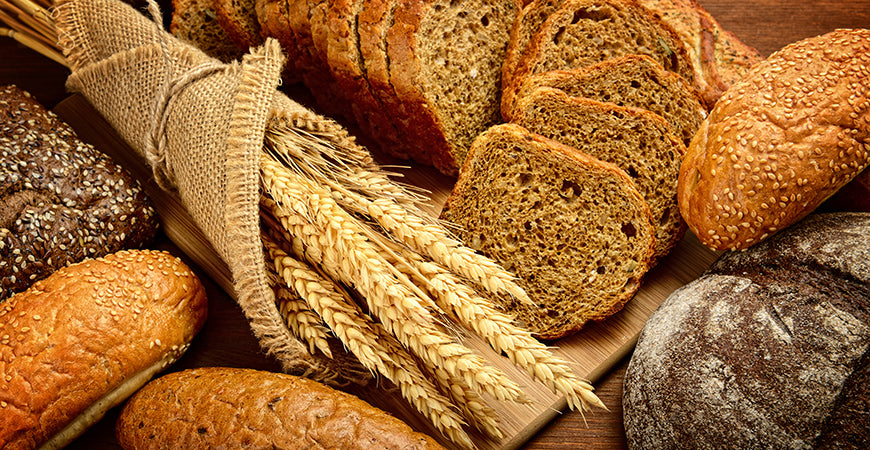on all US orders over $99
on all US orders over $99

For too long, the government nutrition guidelines have centered around cereal grains as the mainstay of the American diet, and as a result we’re sick, fat, tired and depressed. Wheat, which was once the center of everything from our economy to our religious practices, is not the darling it used to be. On top of that, we also have wheat digestion problems. Changes in harvesting, processing, pesticide use, and our digestive health have led to the rapid rise in grain free and gluten free diets.
Gluten, agglutinin, and amylase-trypsin inhibitors are the proteins in grains that cause inflammation and allergic response, even in people without Celiac Disease. All grains have these proteins – wheat, barley and rye have the highest amounts while corn and rice have some of the lowest amounts. Non-Celiac Gluten Sensitivity is a highly debated topic in scientific literature today. The question that remains is whether it’s these proteins causing the intolerance or the anti-nutrients and fermentable carbs.
The 2003 Human Genome Project showed us that less than 1% of all diseases are actually caused by genes. The truth is the environment our genes are exposed to makes us susceptible to illnesses like Celiac Disease. You can have the genes that predispose you to becoming Celiac, but until an unhealthy cellular environment “flips the switch” and turns those genes on, you’re as healthy as anyone else living a similar lifestyle to yours.
This paradigm shift is so important; it takes us from the mindset that illness is inherited – “it’s genetic in my family” – to the reality that it’s the environment you’re exposed to through familiar habits, beliefs, and lifestyles that causes the disease. Celiac Disease is now seen as a product of the environment we’re exposed to, inside and outside of our bodies. This is good news; it takes us from having no control over developing the disease to being able to prevent it with a healthy lifestyle.
Everything in nature has defense mechanisms to keep itself from being eaten. Animals have teeth; grains have anti-nutrients like phytic acid that block essential mineral absorption. Phytic acid blocks the absorption of calcium, iron, phosphorus and zinc from plant-based sources but not from meat. The highest concentrations are found in whole grain rice, wheat and wild rice. Soaking, sprouting or fermenting grains breaks this anti-nutrient down, as does a healthy probiotic population in your digestive tract.
Lectins are sticky little proteins that adhere to the intestinal membrane. When enough of them are present, the lining of the intestines increases its permeability, releasing whole proteins into the blood stream. This condition is commonly called “leaky gut” and is the gateway to autoimmune diseases including allergies and inflammatory bowel disease. Not everyone has a problem with lectins; if you have a good population of healthy probiotics you’ll probably handle them fine. You’ll know you’re sensitive when joint pains, runny nose and stomach issues come shortly after a meal high in lectin-rich foods.
The lectins in grains and legumes (beans) are different from the lectins in nightshade vegetables (eggplant, tomato, peppers). The lectins in vegetables break down once exposed to heat, so cooking them often makes them better tolerated. The lectins in wheat are heat-resistant and stay intact despite cooking.
One reason given for less tolerance of wheat these days is how it’s harvested. Before the combine harvester came on the scene, wheat was harvested by hand and stacked in sheaves. Later, once all the wheat was cut, the harvesters came back and collected the sheaves. The process of stacking the sheaves led to alternate cycles of drying then fermenting, depending on rainy or sunny weather. These cycles broke down the phytic acid and made the wheat more digestible.
With the invention of the combine harvester, wheat is processed as its harvested, and is stored in grain bins and silos right after harvest. Instead of the fermentation we used to get, now only a little moisture accumulates as it’s stored and mold is the result. The mold toxins stay with the wheat and other grains including corn, even when it’s processed into flour.
We inhale and ingest these molds and their toxins as we prepare or eat these foods. These mycotoxins cause cancer, hormone disruption and inflammation. Adding in the pesticides and herbicides like glyphosate, grains become even more toxic. Another toxic concern are the high levels of arsenic found in many rice crops (due to the soil where it’s grown). Rinsing rice before cooking and cooking in extra water, then draining it before eating will get rid of most of it.
Grains are mostly carbs and sugars, with only a little protein and fat. Unless you are active enough to burn these calories right away, your body will store these sugars as fat in just a few hours after eating them. As those carbs cause your blood sugar to rollercoaster up and down, insulin rises and causes more sugar cravings and unsatisfied hunger. This is the perfect storm that leads to weight gain, insulin resistance and Type II Diabetes. The best way off this rollercoaster ride to disease is a diet high in healthy fats and low in grain-based carbs, like Ann Louise Gittleman’s Fat Flush Plan.
Leave a comment